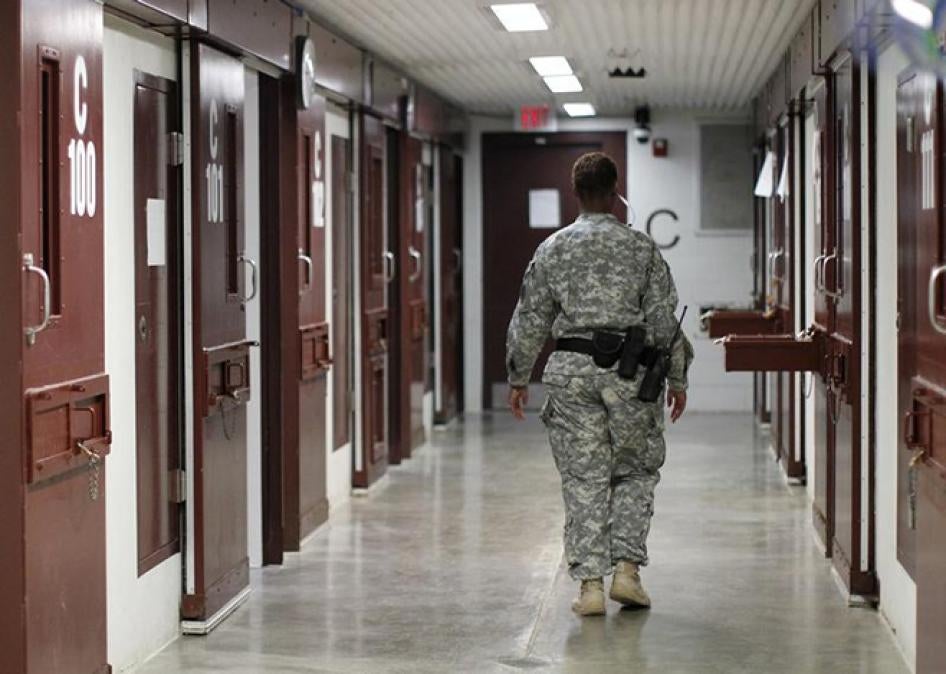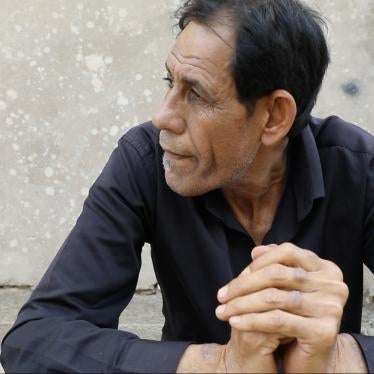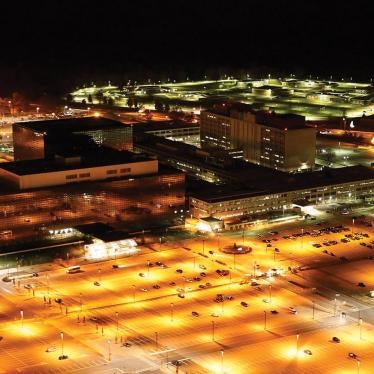As the administration of President Barack Obama whittles down the numbers of detainees at Guantánamo Bay, transferring 15 men to the United Arab Emirates this week, some members of Congress, including Republican Senator Kelly Ayotte, from New Hampshire, are once again making alarmist claims about the released detainees’ supposed dangerousness. Calling those released “among the worst terrorists,” Ayotte warned that Obama was jeopardizing national security by freeing them and planning for the release of others. Despite the vehemence with which these claims are made, the basis for them is remarkably misguided.
The bottom line is that many of those who have been detained in Guantánamo for the last 15 years were never involved in terrorism to begin with. The reported number of those who have become involved in terrorism after their release is low—and even that number is contested. The greatest danger that Guantánamo poses to U.S. national security is its potency as a symbol of injustice—the product of holding hundreds of people for years without due process and its association with rendition and torture—as it often feeds into terrorist propaganda. That is one reason why former President George W. Bush, as well as U.S. national security leaders, such as former chairman of the Joint Chiefs of Staff Mike Mullen and former Secretary of State Colin Powell, have supported shutting Guantánamo down.
In arguing against the release of the detainees, Ayotte cited a report issued by the Pentagon on August 10 that elaborated on the background of the 107 prisoners who were still in Guantánamo as of last November. She highlighted the few lines about them that included what extremist groups they had allegedly been associated with and actions they had taken in support of those groups, which the government had used for years to justify the continued detentions. The information tracks with the 2008 classified military assessments of detainees that WikiLeaks leaked to the public in 2011. But these assessments contain unreliable information, derived in many cases from torture or, in other cases, from detainees providing false statements about other prisoners in order to get better treatment. Ayotte also failed to mention that the detainees have contested these allegations during hearings, military commission proceedings, and in federal court. In fact, there is a footnote at the bottom of the report’s summary pages cautioning that “some information here may have been contested by individual detainees.” For example, the military initially determined that Ayub Murshid Ali Salih, one of those released to the UAE this week, was part of a group planning attacks against the United States in Karachi. But a Periodic Review Board, made up of representatives from six U.S. national security agencies tasked with determining detainee eligibility for release, said they “disagreed” with those previous assessments and cleared him for transfer.
Although the Director of National Intelligence (DNI) reports that some former detainees have become involved in terrorism or militancy after their release, the number is relatively low. Out of the 144 detainees discharged since 2009, only seven are “confirmed” to have had some involvement. (It is important to note that the DNI uses a “more likely than not” standard in making this determination, meaning that it is just more than 51 percent likely that the label is correct.) Another 11 are “suspected” of involvement, but this is based on “unverified or single-source reporting,” again making the reliability of such judgments questionable. Official numbers are higher among the 532 released under the administration of President George W. Bush, with 111, or 20 percent, listed as “confirmed,” and 74, or 14 percent, “suspected.”
The United States’ definition of “terrorism” includes involvement in plots to attack civilians as well as in “insurgent activities” against “coalition or host-nation forces.” In June, The Washington Post reported that at least 12 former Guantánamo detainees released to Afghanistan during the prior administration were involved in firefights with either U.S. or allied forces there, during which approximately six Americans were killed. However, the attacks mostly occurred during large-scale firefights in war zones, so there was no way to determine whether the former detainees were directly responsible for the U.S. deaths. Nine of those suspected to be involved in the attacks are now dead or in foreign custody.
The DNI has been criticized for not releasing more information about the former detainees involved in the attacks, and about the attacks themselves. The credibility of the DNI figures have also been challenged based on publically available information about terrorist attacks. Even if the DNI figures are correct, however, they are well below the estimated 60 percent U.S. recidivism rate for U.S. criminal convictions. In any event, those who remain at Guantánamo should be judged based on individualized assessments, not on the actions of other former detainees who were released years ago and with whom they have no connection.
Still, some members of Congress continue to cry foul, and Ayotte has been leading the charge. If she had her way, not even one more Guantánamo detainee would be released in the near future. Earlier this year she introduced an amendment to an annual defense bill, which is still under negotiation, that would have barred detainee transfers to all countries until September 2017 and made permanent the ban on transferring detainees to the United States for continued detention or trial. Eventually, the amendment was scrapped, but it was replaced with another restrictive measure that would add an additional 26 countries to the four already prohibited from receiving detainees—Libya, Somalia, Syria, and Yemen. Lengthening this list could make negotiating future transfers even more difficult and obstruct the release of the 20 remaining detainees the administration has already cleared for transfer. Further, the Obama administration already takes its own factors, as well as congressionally mandated security factors, into consideration before transferring any detainees out of Guantánamo. These include assessing whether detainees transferred to a specific country have become involved in terrorism there, the ability of certain countries to oversee facilities where detainees may be held, and a country’s willingness to share information with the United States about detainees.
Among the 20 cleared for transfer are detainees like Mustafa al Shamiri and Abdul Zahir, both of whom were originally designated by a special interagency task force set up by Obama in 2009 as “too dangerous to release” but were actually cases of mistaken identity. The U.S. government initially thought that Shamiri, who was 16 or 17 years old at the time of his detainment, was “a senior trainer at the al-Faruq Training Camp as well as an al-Qaida guesthouse logistician.” A later assessment notes that “these activities were carried out by other known extremists with names or aliases similar to [Shamiri].” And yet Shamiri has been at Guantánamo for more than 14 years. Zahir was detained at the age of 30 or 31, during a raid intended to capture someone else, in a location where chemical or biological agents were believed to be stored. It was later determined that the agents were benign substances. Zahir has been imprisoned for 13 years and ten months.
Mohamedou Ould Slahi, another detainee set for release, allegedly had terrorist ties, but the military prosecutor refused to take action against him after learning that Slahi had made his most incriminating statements, which formed the core of the government’s case against him, under torture. Slahi, who was cleared in July, has been at Guantánamo for 14 years. He wrote a memoir, Guantánamo Diary, that his lawyers fought for years to get released. When it was, it became a New York Timesbest-seller. In it, Slahi detailed years of harrowing torture and abuse, but he often does so with humor and compassion, even when writing about those responsible for his pain.
In 2008, after many years at Guantánamo, all detainees, including Slahi, Shamiri, and Zahir, finally won the right to challenge their detention in U.S. federal court habeas proceedings. Some won their cases at the lower court level, but U.S. appellate courts reversed these decisions, upholding the right of the administration to detain individuals—based on very little evidence that is, furthermore, weighed in the government’s favor—until the end of hostilities, whenever that may be. But this ruling does not comport with U.S. obligations under human rights law.
In 2009, while at the same time fighting detainee habeas cases in federal court, the Obama administration established its own interagency task force that deemed 48 detainees “too dangerous to release,” and yet also assessed that they could not be prosecuted because the evidence against them was either inadmissible or didn’t amount to a chargeable offense. Thirty-seven of them have received Periodic Review Board hearings, conducted by members of six military and national security agencies, to determine detainee eligibility for release, and 26 of them have been cleared. Of those, 17 have been released.
Of course, some of those still held in Guantanamo may harbor ill-intensions or ill-will to the United States and may have committed serious crimes. But the proper way to treat them, for a country that respects the rule of law and international human rights, is to prosecute them before a fair court of law if the evidence supports it, not hold them indefinitely or subject them to torture. Abu Zubaydah, for instance, was initially thought to be one of al Qaeda’s most senior leaders, but it has since become apparent that he was not even a member of the group. It seems that he at least knew al Qaeda members and sympathized with the 9/11 attacks, but he should have faced trial, not endless detainment, and, as the Senate Intelligence Committee extensively documented in December 2014, brutal torture to the point of near death.
Other detainees, like Riduan bin Isomuddin (also known as Hambali), have been accused of serious crimes. Hambali is alleged to have helped facilitate terrorist financing for the 2002 Bali bombings in Jakarta, which killed more than 200 people. Although the Periodic Review Board, gave him a hearing this week, his lawyer, Carlos Warner, a federal public defender based in Ohio, could not attend because he said it was hastily scheduled. The board rejected Warner’s offer to hold the hearing in September when he would be in Guantánamo on another case. Hambali has been held for years, along with Zubaydah and 12 other so-called high-value detainees at Guantánamo’s secret Camp 7. The U.S. government has denied nongovernmental observers, the United Nations Special rapporteur on torture, and journalists access to the Camp 7.
One critique against giving such detainees a fair trial is that the prosecutions are inadequate at prevention—they can only address crimes that have already occurred and cannot consider future threats. This is not true. As Kenneth Roth, the Executive Director of Human Rights Watch, where I work, has pointed out in Foreign Affairs, courts can prosecute under the federal crime of conspiracy to commit terrorism, which looks at whether two or more people committed to an illegal plan and took at least one step to advance it. Similarly, the crime of providing “material support” to a terrorist organization does not necessarily involve the commission of a terrorist act but rather the support of a terrorist organization or terrorism.
But as it stands these charges are not available for most detainees at the Guantánamo military commissions because they are not currently considered war crimes. (And no one should be tried under that fundamentally flawed system in any case.) One of the reasons the Obama administration wants to bring detainees to the United States is so that they can be prosecuted in federal court. At the very least, U.S. Congress should lift the ban on this transfer for the purpose of bringing them to trial, but absent this, Washington should not substitute indefinite detention in place of due process. Anyone who cannot be fairly tried for their alleged crimes should be released.
The choice of keeping Guantánamo open thus boils down to whether the United States should continue a system that contradicts its very values and sets a terrible precedent both domestically and for the rest of the world: indefinitely detaining those who Washington thinks might commit some dangerous act in the future but who have not been charged with a crime. This practice is even more of a risk to U.S. national security than the release of any one detainee, since the chance of released detainees becoming involved in terrorism is so objectively low. The vast majority of those released from Guantánamo are living peaceful lives. No matter what Ayotte or the administration may assert about the remaining detainees’ “dangerousness,” even those accused of the worst crimes require a fair trial. Washington should not forget this most basic element of justice.







